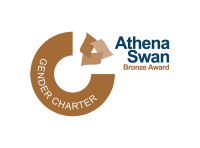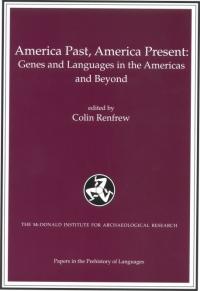
Our full catalogue is presented here by publication date. Our publications are distributed by Pen & Sword Books/Casemate Academic. Direct links to Pen & Sword Books are included in the catalogue where the book is still in print. We also sell some of our publications as e-books.
Publications
America past, America present | Archaeogenetics | Hunter-gatherer landscape archaeology | Neolithic Orkney in its European context | Time depth in historical linguistics | Towards reflexive method in archaeology | Cognition and material culture | Late prehistoric exploitation of the Eurasian steppe | Nostratic | The Nostratic macrofamily and linguistic palaeontology | Excavations at Tell Brak, vol. 1 | Star Carr in context | Klithi | On the surface | Modelling the early human mind
2000
America past, America present: genes and languages in the Americas and beyond
edited by Colin Renfrew
Paperback | £30/US$50 | ISBN 978-1-902937-01-4 | x + 175 pp. | 12 figs. | 13 tables | 2000 | Out of print: e-book coming soon

Aspects of the prehistory of the Americas currently remain little understood, with suggested dates for the first human colonization varying widely between 40,000 and 14,000 years ago. In this volume molecular geneticist and historical linguists debate the evidence for the first peopling of the Americas, and for the subsequent emergence of the remarkable genetic and linguistic diversity still seen among Native Americans to this day. The arguments against the controversial ‘three waves of migration’ proposal made by the distinguished linguist Joseph Greenberg are scrutinized.
Archaeogenetics: DNA and the population prehistory of Europe
edited by Colin Renfrew and Katie Boyle
Hardback | £38/US$60 | ISBN 978-1-902937-08-3 | xxiv + 342 pp. | 103 figs. | 2000 | Out of print: e-book coming soon
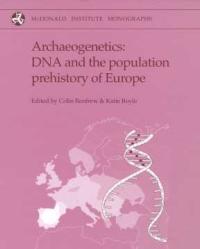
Recent developments in molecular genetics are currently transforming our understanding of the population history of the world. Their application to the prehistory and history of Europe was the focus of an interdisciplinary meeting held in Cambridge in 1999 as a Euroconference of the Human Genome Diversity Group. The papers describe the latest developments in this fast-moving area, with a clear and accessible discussion of the results of mitochondrial DNA and Y-chromosome analysis, and of their integration with the archaeological and climatic record. For the first time it is here possible to assess the impact of molecular genetics upon European prehistory.
Hunter-gatherer landscape archaeology: the Southern Hebrides Mesolithic Project 1988–98 (2 vols.)
edited by Steven Mithen
Hardback | £88/US$150 | ISBN 978-1-902937-12-0 | 2 vols. | xviii + xiv + 652 pp. | 566 figs. | 242 tables | 2000 | Buy now
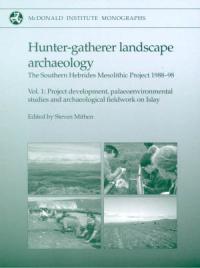
This is the definitive publication of the ten-year Southern Hebrides Mesolithic Project. The project aimed to document Mesolithic settlement on the islands of Islay and Colonsay and, in intepreting it, to throw light on a number of major issues: the colonization of Scotland following the last Ice Age; the nature of early postglacial settlement patterns; and the transition to Neolithic and farming communities.
Neolithic Orkney in its European context
edited by Anna Ritchie
Hardback | £45/US$70 | ISBN 1-902937-04-X | xiv + 342 pp. | 193 ills. | 12 tables | 2000 | Out of print: e-book coming soon
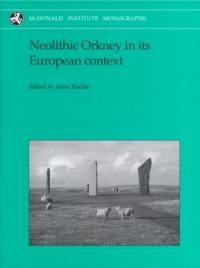
In the far north of the British isles, the islands of Orkney have a wealth of well-preserved monuments. They have inspired this volume of essays by international scholars, who offer new ideas about life and death, monuments and landscapes, not just in Orkney but also in the rest of Britain and Europe. From Ireland to Eastern Europe and north to Scandinavia, an inter-relating pattern of social practices in the Neolithic can be traced through archaeological excavations and close observation of upstanding monuments.
Time depth in historical linguistics (2 vols.)
edited by Colin Renfrew, April McMahon and Larry Trask
Paperback | £50/US$80 | ISBN 1-902937-06-6 | 2 vols. | Vol 1: xiv + 307 pp. | 20 figs. | 4 tables | Vol. 2: vi + 371 pp. | 41 figs. | 29 tables | 2000 | Out of print
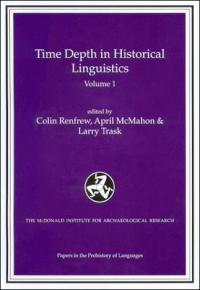
Time depth constitutes one of the most difficult problems in historical linguistics, its evaluation being crucial for any systematic comparison with archaeological or genetic data, and hence basic to any broader historical interpretation. Time Depth in Historical Linguistics will be indispensable for anyone seriously concerned with issue of time depth in languages, and for all archaeologists and geneticists seeking an integration between their own discipline and the early history of languages.
Towards reflexive method in archaeology: the example at Çatalhöyük
edited by Ian Hodder
Hardback | £45 / US $70 (Special price: £14.95 / US $29.98) | ISBN 978-1-902937-02-1 | xvi + 238 pp. | 71 figs. | 10 tables | 2000 | Buy now
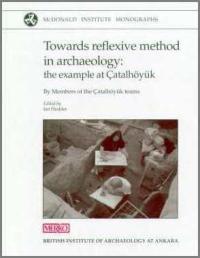
In the early 1990s the University of Cambridge reopened excavations at the Neolithic site of Çatalhöyük in central Turkey, abandoned since the 1960s. This is Volume 2 in the Çatalhöyük Research Project series. Here Ian Hodder explains his vision of archaeological excavation, where careful examination of context and an awareness of human bias allows researchers exciting new insights into prehistoric cognition. The aim of the volume is to discuss some of the reflexive or postprocessual methods that have been introduced at the site in the work there since 1993. These methods involve reflexivity, interactivity, multivocality and contextuality or relationality.
1999
Cognition and material culture: the archaeology of symbolic storage
edited by Colin Renfrew and Chris Scarre
Hardback | £45/US$80 | ISBN 978-0-951942-06-2 | 200 pp. | 58 figs. | 8 tables | 1999 | Out of print:
e-book | £24 | ISBN 978-1-902973-57-1 | Buy now
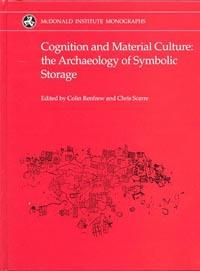
The material expression of human cognitive development is one of the most exciting and important fields of current archaeological research, exemplified most clearly by the attention given in recent years to the emergence of modern humans. But what of the cognitive changes which have taken place since the beginning of the Upper Palaeolithic? The present volume, the result of a conference held in Cambridge in 1996, takes as its starting point the provocative study of Origins of the Modern Mind by Merlin Donald, and addresses the question of cognitive change in recent millennia through the development and role of material symbols in holding and conveying information and ideas – Donald's concept of 'External Symbolic Storage'.
Late prehistoric exploitation of the Eurasian steppe
edited by Marsha Levine, Yuri Rassamakin, Aleksandr Kislenko & Nataliya Tatarinteseva
Hardback | £40 / US $70 | ISBN 978-1-902937-03-8 | 216 pp. | 133 ills. | 26 tables | 1999 | Buy now
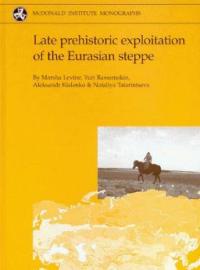
The nomadic peoples of the great grasslands of the former USSR have left little in the way of settlement evidence, and archaeologists studying their history have had to rely on environmental remains to reconstruct their pasts. This book contains three major studies: The origins of horse husbandry on the Eurasian Steppe (M Levine); The eneolithic of the Black Sea Steppe: The dynamics of cultural and economic development 4500–2300 BC (Y Rassamakin), and The Eastern Ural steppe at the end of the Stone Age (A Kislenko and N Tatarintseva). Each presents evidence that has not previously been available to European prehistorians. The whole provides an important contribution to European prehistory, and provides background to the ongoing discussions on the prehistory of language.
Nostratic: examining a linguistic macrofamily
edited by Colin Renfrew and Daniel Nettle
Paperback | £30 / US $54 | ISBN 978-1-902937-00-7 | xxii + 398 pp. | 428 figs. | 1999 | Buy now
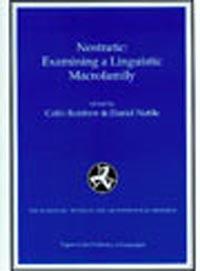
This volume of essays examines the claim that a linguistic macrofamily can be identified which includes not only the Indo-European and Afroasiatic language families but also the Kartvelian, Uralic, Altaic and Dravidian families. The Nostratic case was put by Aharon Dolgopolsky in his The Nostratic Macrofamily and Linguistic Palaeontology, and it is here evaluated critically by linguists specialising in the language families concerned.
The Nostratic macrofamily and linguistic palaeontology
edited by Aharon Dolgopolsky
Paperback | £20/US$36 | ISBN 978-0-951942-07-9 | xxii + 116 pp. | 1999 | Buy now
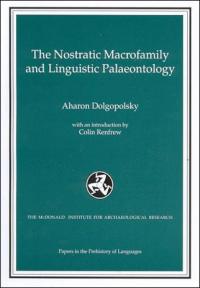
Do all or most languages in the world descend from a single proto-language? And if so what can we tell from linguistic analysis about the speakers of this ancient tongue? These are the two questions at the heart of this controversial book and the themes clearly outlined by Colin Renfrew in his introduction. The theory of a Nostratic proto-language is not new, but the extremely detailed presentation of historical linguistic evidence provided here is. The lists of possible linguistic roots are not for the faint-hearted, but for serious linguists they provide real meat on which to chew, and, the publishers hope, provide a solid basis for debate.
1998
Excavations at Tell Brak, vol. 1
edited by David Oates, Joan Oates and Helen McDonald
Hardback | £45/US$80 | ISBN 978-0-951942-05-5 | 296 pp. | 178 figs. | 1998 | Out of print: e-book coming soon
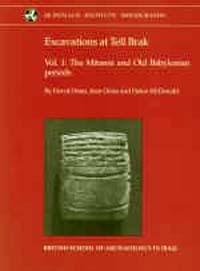
This is the first of four volumes on the excavations at Tell Brak in northeast Syria, ancient Nagar/Nawar, one of the largest urban sites in northern Mesopotamia. Here the second-millennium BC material is published in full, including a detailed account of the monumental Palace and Temple of Mitanni date (Late Bronze Age) and a sequence of second-millennium domestic occupation dating from c. 1700–1200 BC. This is the most extensive and best-dated Mitanni material yet known. Of especial interest is unique evidence from Palace workrooms for craft activities involving materials such as glass, iron, copper, bronze and ivory. Official cuneiform records add to our historical knowledge of this important but archaeologically little-known kingdom.
Star Carr in context
edited by Paul Mellars and Petra Dark
Hardback | £40/US$70 | ISBN 978-0-951942-04-8 | 250 pp. | 1998 | Out of Print: e-book coming soon
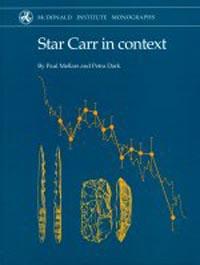
A summary of findings from the most recent archaeological and palaeoecological investigations at the Early Mesolithic occupation site. The new programme of research, intended to shed further light on problematic issues such as the exact age, duration, and pattern of occupation, and the precise nature of the birch brushwood platform, called for the use of scientifically more advanced techniques not before available.
1997
Klithi: Palaeolithic settlement and Quaternary landscapes in northwest Greece (2 vols.)
edited by Geoff Bailey
Hardback | £70 / US $70 (Special price: £24.95 / US $39.98) | ISBN 978-0-951942-02-4 | 2 vols. | Vol 1: xx + 316 pp. | 187 ills. | 121 tables | Vol 2: xvi + 380 pp. | 231 ills. | 64 tables | 1997 | Buy now
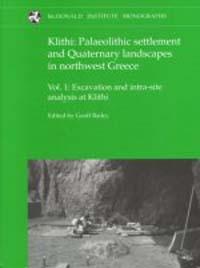
The Epirus region of northwestern Greece has witnessed more dramatic changes of physical landscape than almost any other part of Europe. Tectonic activity has shaped a complex and dynamic topography, supplemented by the impact of a local ice sheet formed during the Glacial Maximum, and dramatic episodes of erosion triggered by changes of climate, vegetation and land use. These two volumes set out the history of Palaeolithic occupation over the past 100,000 years, bringing together the full range of studies carried out between 1981 and 1993 as part of the Klithi Project.
On the surface: Çatalhöyük 1993–95
edited by Ian Hodder
Hardback | £40 / US $70 (Special price: £14.95 / US $29.98) | ISBN 978-0-9519420-3-1 | 368 pp | 206 ills. | 63 tables | 1997
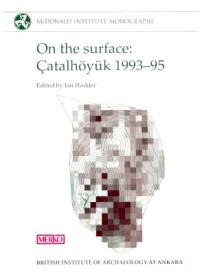
After the excitement of its discovery and excavations in the early 1960s, the world-important site of Çatalhöyük has remained dormant for 30 years. This is Volume 1 of the Çatalhöyük Research Project series. It describes the first phase of renewed archaeological research at the site. It reports on the work that has taken place on the surfaces of the east and west mounds and in the surrounding regions. It also discusses the material from the 1960s excavation in museums, which has been re-examined. The result is that new perspectives can be offered on the internal organization and symbolism of a site which is central to our understanding of the earliest development of complex societies.
1996
Modelling the early human mind
edited by Paul Mellars & Kathleen Gibson
Hardback | £45/US$80 | ISBN 978-0-9519420-1-7 | x + 229 pp. | 38 figs. | 20 tables | 1996 | Out of print: e-book coming soon
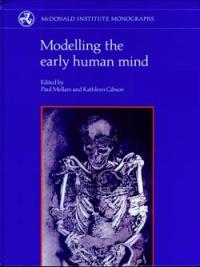
This volume is based on a conference held by the McDonald Institute for Archaeological Research in Cambridge in September 1993. The aim of the conference was to address key issues in the development of intelligence and cognitive capacities through the course of human evolution. It did this by invoking theoretical perspectives from a broad range of relevant disciplines — psychology, ethology and primate behaviour, neurology, child development, artificial intelligence and, of course, archaeology. The volume contains the papers presented at the conference, revised and updated in the light of post-conference discussions. It provides the more comprehensive review available of current approaches to ‘modelling’ the evolution of intelligence and cogntion in early human populations.

